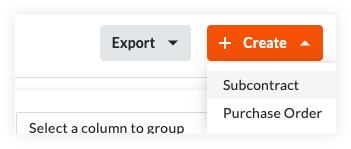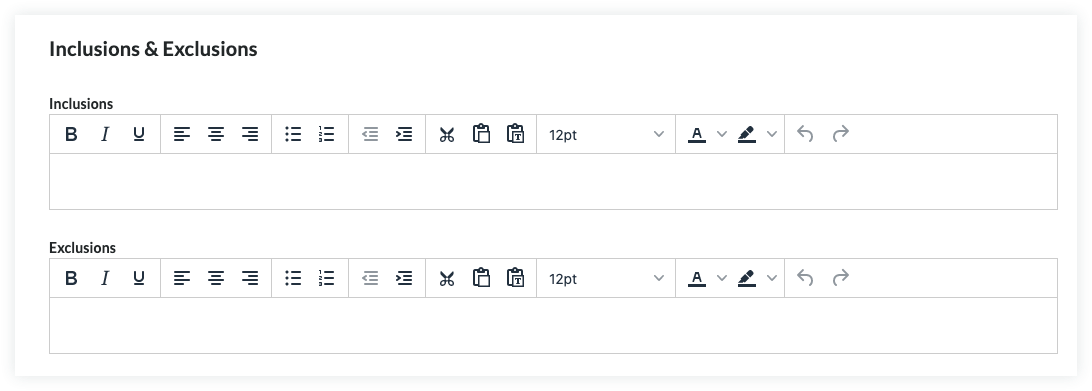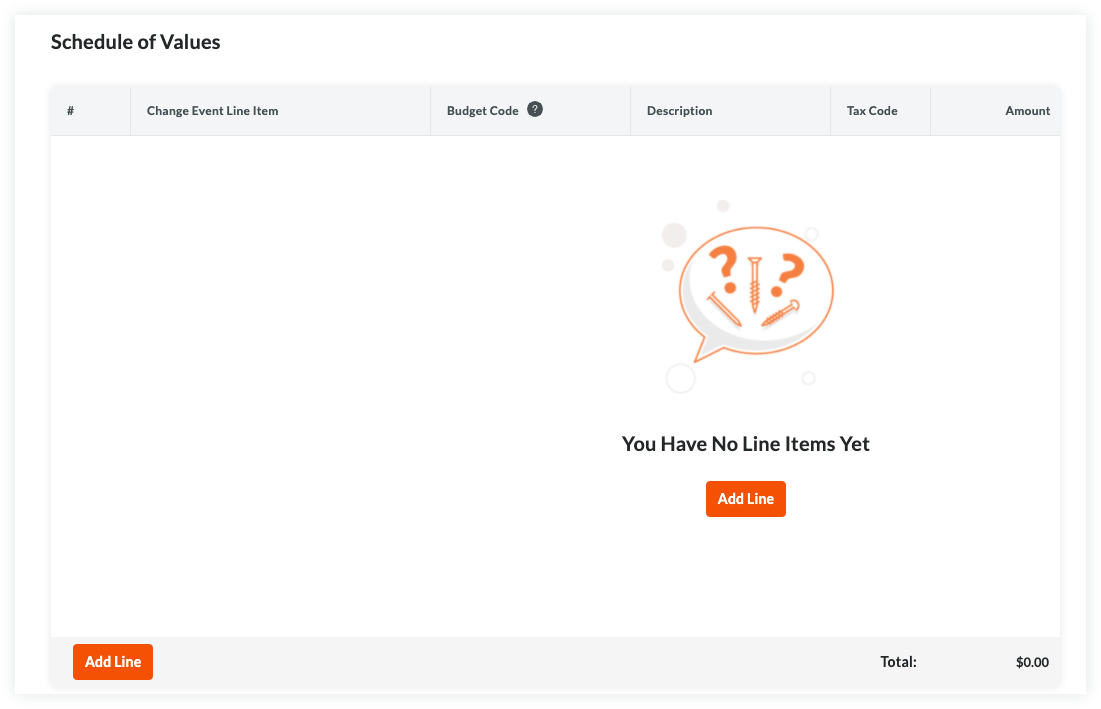Create Subcontracts
Objective
To create a subcontract in Procore using the project's Commitments tool.
Background
Subcontracts can be awarded during both the preconstruction and construction phases of a project and are typically created and tracked in Procore by project management. After a main contract award, the project manager creates purchase orders and subcontracts for specific trades to secure materials and subcontractor services for a project.
Things to Consider
- Required User Permissions:
- To create a subcontract and see/enter data on the Bill of Quantities (BOQ) tab:
- 'Admin' level permissions on the project's Commitments tool.
OR - 'Standard' level permissions on the project's Commitments tool and the 'Allow Users to See BOQ Items' setting must be enabled and your name must be selected in the 'Select a Person' drop-down list
- 'Admin' level permissions on the project's Commitments tool.
- To create a subcontract only, 'Read Only' or 'Standard' level permissions on the project's Commitments tool with the 'Create Work Order Contract' granular permission enabled on your permissions template.
- To create a subcontract and see/enter data on the Bill of Quantities (BOQ) tab:
- Additional Information:
- An alternative way to create a subcontract is to award a winning tender and convert it into a subcontract. See Award a Winning Tender and Convert it into a Subcontract.
- To set the accounting method for the subcontract, see How do I set the accounting method for a contract or funding?
- After creating a subcontract, you have these options for creating variations:
- If your subcontract is configured for 1-Tier Variations. Continue with Create a Commitment Variation.
- If your subcontract is configured for 2-Tier Variations. Ensure the subcontract is in the 'Approved' status and continue with Create a Commitment Potential Variation from a Change Event.
- If your subcontract is configured for 3-Tier Variations. Ensure the subcontract is in the 'Approved' status and continue with Create a Commitment Potential Variation from a Change Event.
Prerequisites
- Configure Settings: Commitments
- To use the Procore + DocuSign® integration to request signatures, see DocuSign®.
Steps
- Navigate to the project's Commitments tool.
- On the Contracts tab, click the Create button and choose Subcontract from the drop-down list.

- Continue with the next steps:
Add the Basic Information
Update the basic information as follows:

Notes
- There are no required fields when adding the basic information.
- If you click the Create button without completing any data entry, Procore saves the contract, lists you as the creator and automatically places it in the Draft status.
- Contract Number
To number your contract(s), choose from these options:- If you number your contracts using a sequential numbering system, you can enter any combination of alpha-numeric characters in this box. For subsequent contracts, Procore automatically applies consecutive numbering in ascending order.
Example
The examples below show you how Procore's ascending consecutive numbering works:
- If the previous contract was 1, the next contracts are 2, 3 and so on.
- If the previous contract was PC-0001, the next contracts are PC-0002, PC-0003 and so on.
- If the previous contract was DCA00010-12-G-0001, the next contracts are DCA00010-12-G-0002, DCA00010-12-G-0003 and so on.
- If you do NOT number your contracts using sequential numbering, you can manually enter a unique number for each main contract. To do this, type over the existing entry in the Number box. Duplicate contract numbers are NOT permitted.
- If you number your contracts using a sequential numbering system, you can enter any combination of alpha-numeric characters in this box. For subsequent contracts, Procore automatically applies consecutive numbering in ascending order.
- Contract Company
Select the name of the project owner's or the project client's company from the drop-down list. This is the company that either owns the construction project or the client who has hired your company to oversee the project work. To appear as a list option, Add a Company to the Project Directory. - Title
Type a descriptive name for the contract. - Optional: Sign with DocuSign®
Move this toggle to the right to collect signatures with the Procore + DocuSign® integration. To learn how to activate the integration in Procore, see Enable or Disable the DocuSign® Integration on a Procore Project.
Update the General Information
Update the contract with more general information:

- Status
Procore automatically assigns contracts the 'Default' status. To select a different status, choose one of the status labels from the drop-down list. Options includeNote
To create variations and payment applications, your contract's status must be set to Approved or Complete. - Executed
Place a mark in this tickbox if the contract has been fully executed. A fully executed contract is a legally effective agreement that has been signed by authorized representatives for each party. - Default Retention
Enter a number to represent the percentage that will be withheld as retention on the line items of the contract's Bill of Quantities. For example, if you plan to withhold ten (10) percent of the line item's value, enter 10%. - Description
Enter a more detailed description of the main contract. You can apply the options in the formatting toolbar to your text.
Update the Contract Access
Using the privacy setting allows only project admins and the select non-admin users access. To change the contract's access permissions, do the following:
- Check or Untick the 'Private' box. Procore turns this setting ON by default.
- Select an employee of the 'Contract Company' from the Payment application Contact drop-down list.
Update the Contract Dates
To update the contract with important dates, do the following:

Note
Your company's Procore Administrator manages the dates that appear in the 'Contract Dates' section using the configurable fieldsets feature. For details, see Which fields in the Commitments tool can be configured as required, optional or hidden?- Start Date
Select the construction project's official start date. - Estimated Completion
Select the construction project's estimated completion date from the calendar control. - Actual Completion
Select the construction project's actual completion date. - Signed Contract Received
Select the date from the calendar control. The signed contract received represents the date that the executed contract was received.
Add the Scope of Work
Contract inclusions and exclusions vary from project to project. However, the intent is to define exactly what is included and NOT included in the contract's price and scope of work. To update the contract's 'Inclusions and Exclusions' card, do the following:

- Inclusions
Add the contract's inclusions in this box. You can apply the options in the formatting toolbar to your text. - Exclusions
Add the contract's exclusions in this box. You can apply the options in the formatting toolbar to your text.
Set the Accounting Method
The first step when updating a Bill of Quantities is to define the accounting method for the contract. The method you choose also applies to all variations and/or payment applications for that contract. The accounting method can only be changed BEFORE you add line items to a BOQ. Procore does NOT permit you to change a contract's accounting method after line items are added.
Tip
What's the difference between the Amount Based and Unit/Quantity Based contract? For details, see How do I set the accounting method for a contract or funding?- To change the accounting method to Unit/Quantity, click the Change to Unit/Quantity button.
- To change the accounting method back to Amount-Based, click the Change to Amount Based button.
Update the Bill of Quantities
There are two (2) methods for updating the subcontract's BOQ:
- Add Line Items to the Bill of Quantities
- Import Line Items to the Bill of Quantities from a CSV File
Add Line Items to the Bill of Quantities
By default, you can input line items on the subcontract's BOQ at any time, as long as it is NOT in the 'Approved' status.
Note
If your project team has turned the 'Enable Always Editable Bill of Quantities' configuration setting ON in this tool, users with the required user permission to Edit Subcontracts can add line items to the Bill of Quantities when a contract is in any status. To learn specific information about this setting, see What is the 'Enable Always Editable Bill of Quantities' setting?To manually add line items to the Bill of Quantities:

- Choose from these options:
- If the BOQ is blank, click Add Line under 'You Have No Line Items Yet'.
OR - If you have existing line items, click Add Line.
Procore creates new line items starting with the number '1'. Subsequent lines are created in numerical order.
- If the BOQ is blank, click Add Line under 'You Have No Line Items Yet'.
- Designate a budget code for the new line item. You have these options:
- To assign an existing budget code to the line item, start typing a code in the Search box and select the matching code from the list.
OR - To create a new budget code for the line item, click the Create Budget Code button. Next, select the appropriate segment items from the drop-down list(s) to satisfy your project's budget code pattern requirements. Then, click Create.
- To assign an existing budget code to the line item, start typing a code in the Search box and select the matching code from the list.
- Depending on the accounting method you are using, choose the appropriate steps for adding a line item:
- For an Amount-Based contract:
An Amount-Based BOQ requires this data entry:- Budget Code
Select a budget code or click Create Budget Code. See What is a budget code in Procore's WBS? - Description
Enter a description for the line item. For example, type: Monthly Service Fee - Amount
Enter the total amount for the line item. - Billed to Date
Later, when you create payment applications, this column will automatically show the amount that has already been billed to date. - Amount Remaining
Later, when you create payment applications, this column will automatically show the amount that has NOT yet been billed to date.
- Budget Code
- For a Unit/Quantity Based contract:
A Unit/Quantity Based BOQ requires this data entry:- Budget Code
Select a budget code or click Create Budget Code. See What is a budget code in Procore's WBS? - Description
Enter a description for the line item. For example, type: Monthly Service Fee - Qty
Enter the number of units. - UoM
Select the Unit of Measure (UoM) from the list. See Which units of measure are included on Procore's master list? and Add a Unit of Measure to the Unit of Measure Master List. - Unit Cost
Enter the Unit Cost in this box. You'll notice that the value in this column contains four (4) decimal points (for example, £0.0000) to allow you to enter the specific value required to calculate accurate pricing.Example
If you are buying 50,000 units for £1,006,625.00, you would enter a unit price of £20.1325. - Amount
The system automatically calculates the subtotal for you, based on the Qty, UOM, and Unit Cost entries. - Billed to Date
Later, when you create payment applications, this column will automatically show the amount that has already been billed to date. - Amount Remaining
Later, when you create payment applications, this column will automatically show the amount that has NOT yet been billed to date.
- Budget Code
- For an Amount-Based contract:
- Optional: Repeat the steps above to add as many line items as needed.
- Click Save.
Procore saves the line items on the contract's BOQ.
Import Line Items to the Bill of Quantities from a CSV File
- In the 'Bill of Quantities' card, click the Import BOQ from CSV button.

- Click the Download CSV Template button and choose one of these options:
- Blank Template. Click this option to download a blank template.
OR - Template with Existing Line Items. Click this option to download a template that includes any existing line item data from your project's budget.
Note
- Procore downloads a CSV template file to your web browser's file download location.
- The name of the file is: TBD
- Blank Template. Click this option to download a blank template.
- Open the template that you downloaded on your computer.
- Enter the data that you want to upload directly into the template.
Important
Do NOT change or rearrange the Column Headings in the template file. - After entering your line item data, make sure to save your file updates in the 'Comma Separated Values' file format.
- Navigate back to Procore. Then, in the 'CSV File' section, choose one of these options:
- Click Upload File.
OR - Use a drag-and-drop operation to move the template you just updated into the 'CSV File' section.
- Click Upload File.
- Choose one of these options:
- Add Additional Line Items. Choose this option if you want to create new line items using the data in your template.
OR - Replace Existing Line Items. Choose this option if you want to erase any existing line items from the subcontract and replace them with data in your template.
Note
If the 'Enable Always Editable Bill of Quantities' configuration setting is turned ON in the project's Commitments tool, the 'Replace Existing Line Items' option is greyed out and unavailable for use once a payment application is created and line items are billed. To learn more, see What is the 'Enable Always Editable Bill of Quantities' setting?
- Add Additional Line Items. Choose this option if you want to create new line items using the data in your template.
- Click Import.
Attach Files
To add file attachments to the contract:
- On the 'Attachments' card, click Edit.
- Click Attach Files.
- In the 'Attach Files' dialogue box, highlight the location where the files to upload are stored. Options include:
- My Computer. Click Upload Files to open your computer's finder. Select the files to upload and click Open.
- Photos. If the Photos tool is active on the project, choose the location from the Select Album list and then search for the file(s) to upload.
- Drawings. If the Drawings tool is active on the project, choose the area from the Select Area list and then search for the file(s) to upload.
- Forms. If the Forms tool is active on the project, choose the template from the Select Template list and then search for the file(s) to upload.
- Documents. If the Documents tool is active on the project, navigate to the folder storing the file(s) to upload and then highlight them.
- Click Attach.

A progress indicator shows you the status of the upload. - Click the Close (X) icon on the Attach Files dialogue box.
Save the Contract
Note

If the Contract # of the commitment you are creating has been previously used on any project within your company, a confirmation window will appear to ask how you would like to proceed. If you choose to ignore this message, click Save and the contract will be created. Additionally, if you do not want to receive this message when creating future commitments, you may check the box next to the text Don'at as again.
To save the contract, click one (1) of these buttons:
- Create. Click this button to save the new contract and return to the 'General' tab in view mode.
OR - Complete with DocuSign®. Click this button to launch the Procore + DocuSign® integration and prepare the envelope for signature. To learn more, see DocuSign®.
OR - Cancel.

